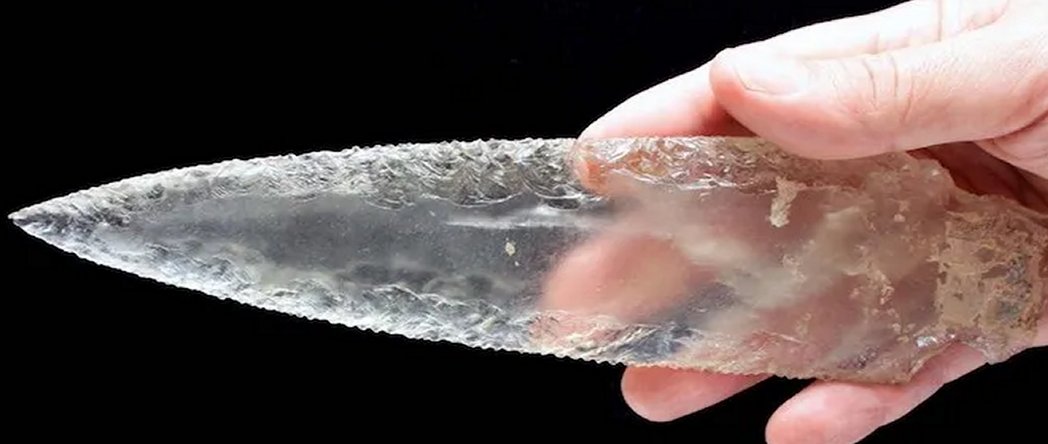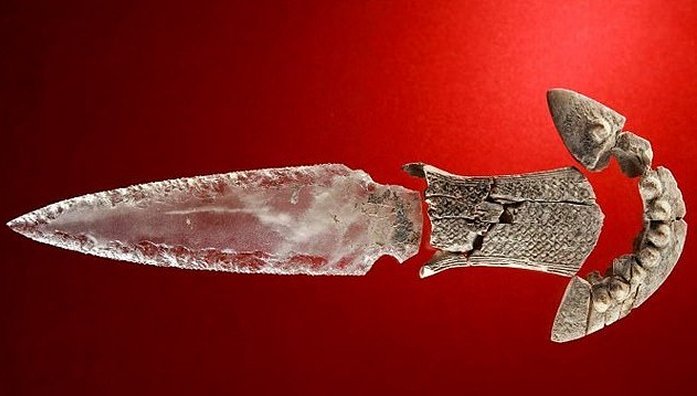Jan Bartek – AncientPages.com – This remarkable 5,00-year-old crystal dagger has been discovered in a megalithic tomb of Montelirio Tholos. It’s a rare dagger because crystal was only available outside of the region and only rich people could possess such a weapon.
According to scientists this translucent weapon the “most technically sophisticated weapon” ever to be found in Prehistoric Iberia, located in Southwestern Spain.

A 5,000-year-old crystal dagger was found in Spain. Credit: Miguel Angel Blanco de la Rubia
The ancient crystal dagger required immense skill to carve. “The manufacture of the rock crystal dagger must have been based on an accumulation of transmitted empirical knowledge and skill taken from the production of flint dagger blades as well from know-how of rock-crystal smaller foliaceous bifacial objects,” researchers wrote in their science paper published in Quaternary International.
The artifact is nearly 8.5 inches long and was found along with 10 arrowheads, four blades and a core for making weapons, all of which were rock crystal.
Inside the megalithic tomb located in the lower Guadalquivir valley that sits within the metropolitan area of Seville, scientists also found the remains of 25 individuals. Some of these people died due to poisoning.
The remains were scattered throughout the site, along with grave goods including elephant tusks, jewelry, pots and one ostrich egg was also found.
The 5,000-year-old crystal dagger may have had a symbolic significance and such societies used it for vitality, magical powers, and connections with ancestors.
‘They probably represent funerary paraphernalia only accessible to the elite of this time period.
The ᴀssociation of the dagger blade to a handle made of ivory, also a non-local raw material that must have been of great value, strongly suggests the high-ranking status of the people making use of such objects,’ the study reads.

The stunning dagger was designed to fit an ivory handle (pictured). Experts say it probably belonged to a person of wealth, as the materials were available in places far from this part of Spain. Credit: Miguel Angel Blanco de la Rubia
The weapon’s face was polished, which may have been done to avoid fractures or accidents while constructing the shape.
See also: More Archaeology News
Due to the dagger’s size, researchers speculate it was taken from a monocrystal at least eight inches long and two inches thick and was designed to fit with an ivory handle.
Valencia is revered as the most significant site from Copper Age Iberia and is also the largest. There are many significant Copper Age sites in Spain. About 5,000 years ago, Los Millares, was the biggest and most important town in Europe. The ruins of the city of Los Millares are situated in a plateau, at an alтιтude of 270 meters – a perfectly chosen strategic location near Almeria, on the southern coast of Spain.
People of Los Millares possessed highly developed technical knowledge and introduced copper metallurgy in the Western Mediterranean Sea. They also developed farming and built a vast necropolis for collective burials.
Written by Jan Bartek – AncientPages.com Staff Writer





